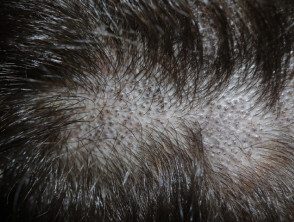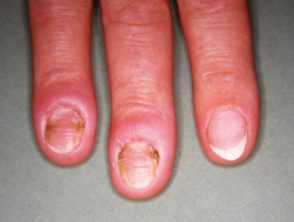Introduction
Fungal skin infections are also known as "mycoses." They are common and generally mild. However, in very sick or immunosuppressed people, fungi can sometimes cause serious illness.
Fungal skin infections

Ringworm of the head

Ringworm

Chronic Paronychia for Candida
Mushroom characteristics.
Fungi are parasites or saprophytes and live on dead or living organic matter.
Mycologists identify and classify fungi based on their appearance by microscopy and in culture, and by the method of reproduction, which can be sexual or asexual.
Growing fungi have branching filaments called hyphae, which form the mycelium (like branches are part of a tree). Some fungi are compartmentalized by crossed walls (called septa).
Arthrospores are made of fragments of hyphae that break in the septa. Asexual spores (conidia) form on conidiophores. The sexual reproductive phase of many fungi is unknown; These are "imperfect fungi" and include those that infect humans.
Yeasts form a fungal subtype characterized by groups of round or oval cells. These sprout similar cells from its surface to divide and spread. In some circumstances, they form a chain of cells called pseudomycelia.
Superficial fungal infections
These affect the outer layers of the skin, the nail and hair. The main groups of fungi that cause superficial fungal infections are:
-
Dermatophytes (ringworm)
- Yeasts: Candida, including the non-albicans candida species, Malassezia, Stone
-
Molds
Subcutaneous fungal infections
These involve the deeper layers of the skin (the dermis, subcutaneous tissue and even bone). The causative organisms lives in the ground on rotting vegetation. They can prick themselves on the skin as a result of injury, but generally remain located at the implantation site. Deeper skin infections include:
- Mycetoma
-
Chromoblastomycosis.
Systemic fungal infections
Systemic mycoses can result from inhalation of fungal spores, which live in the soil or decaying vegetation, or present as an opportunistic disease. immunocompromised individuals.
Inhaled mushrooms infection
Although rare, some can infect healthy individuals. The result is usually a mild infection and long-lasting resistance to new attacks, but occasionally these infections are more severe and chronic (especially in the suppressed immune system). Organisms that cause systemic fungal infections include:
- Histoplasmosis
- Coccidioidomycosis (North and South America).
Opportunistic infection
Other systemic mycoses only infect those who are already ill or have an immunodeficiency disorder (they are "opportunists"). Repeated infection can occur. Systemic mycosis risks include:
- Serious illness and weakness.
- Cancer or leukemia
- Mellitus diabetes
- Transplant
- Bulk doses of antibiotics.
- Parenteral nutrition
- Drug addiction
- Infection with human immunodeficiency virus (HIV)
Opportunistic fungal infections include:
- Aspergillosis (Found everywhere)
- Zygomycosis
- Cryptococcosis (where there are pigeon droppings)
- Trichosporon beigelii
- Pseudallescheria boydii
-
Candida species not albicans.

